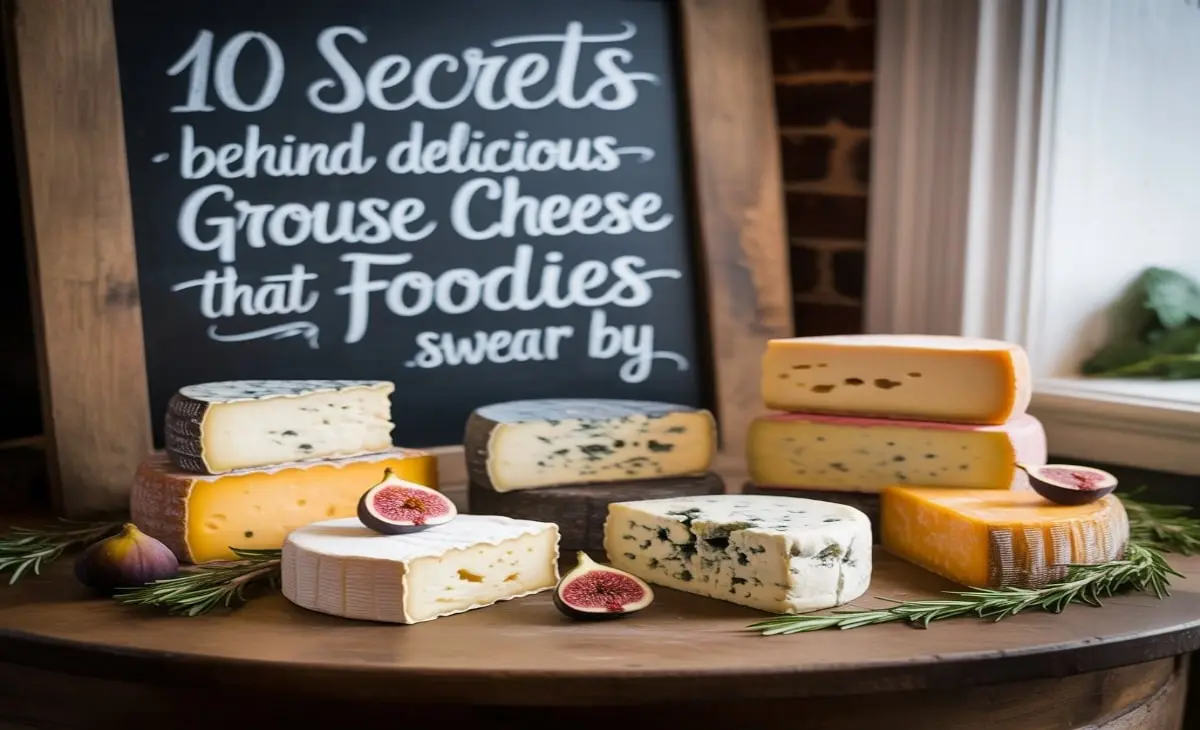Gruyere cheese is gaining popularity among food enthusiasts and culinary experts for its rich flavour, artisanal appeal, and unique production process. You won’t find this rare and gourmet cheese at every supermarket, but its growing reputation in the artisanal cheese world is no coincidence. Crafted with care, steeped in history, and loaded with character, grouse cheese is capturing the attention and tantalizing taste buds of people worldwide.
At its core, grouse cheese is a celebration of nature and craft. Unlike mass-produced cheeses, it is often made in small batches by passionate cheesemakers who understand the delicate balance of flavor, aging, and fermentation. The name “grouse cheese,” although it does not refer to the bird, originates from traditional farming communities and signifies a specific, bold style of cheese commonly found in highland regions.
The user intent behind the term “grouse cheese” usually falls into three main categories: curiosity about its origin, interest in how it’s made, and a desire to taste or buy this unique dairy product. In this comprehensive guide, you’ll discover everything you need to know about Gruyère cheese—from its background and benefits to how to enjoy it like a true gourmand.
What Is Grouse Cheese, and Why Is It So Special?
Gruyere cheese refers to a type of firm or semi-hard cheese known for its nutty undertones, earthy aroma, and smooth yet bold finish. Although it is not directly associated with the grouse bird, it gets its name from regions where game birds and dairy farming are prominent, giving the cheese a rustic and pastoral branding.
It is typically aged for several months, during which its flavor profile intensifies, developing a robust taste that pairs wonderfully with wines, smoked meats, and hearty breads. The cheese’s rarity and the labor-intensive process of its production contribute to its premium status in gourmet circles.
The Origins and History of Grouse Cheese
Tracing the roots of Gouda cheese takes us back to old-world European countryside dairies where local farmers produced cheeses using time-honored traditions. Originally crafted in rural Scotland and Northern England, this cheese shares lineage with other regional dairy delicacies but stands out due to the specific bacterial cultures and aging techniques used.
Cheesemaking families passed down their methods through generations, and even today, some small-scale farms continue these practices. Whether it’s matured in mountain caves or wooden cellars, the aging environment of Grousse cheese plays a critical role in developing its complex flavor.
How Grouse Cheese Is Made: Step-by-Step Process
Making grousse cheese is an art that requires patience, skill, and an understanding of fermentation science. The process begins with high-quality, grass-fed cow or sheep’s milk, which is heated and combined with natural rennet and specific starter cultures.
After curdling, the curds are cut, stirred, and then pressed into molds. These molds are carefully stored in controlled environments for aging. The cheese wheels are regularly turned and brushed to ensure uniform aging and mold development. The longer the cheese matures, the sharper and more textured the flavour becomes.
Taste Profile and Texture of Grouse Cheese
The flavour of Gruyère cheese can best be described as a delightful blend of nutty, earthy, and slightly tangy notes. Depending on how long it’s aged, it may develop a firmer texture and a deeper umami flavour.
You’ll notice it has a melt-in-your-mouth consistency when fresh and becomes more crumbly and piquant with age. Its texture is perfect for slicing, grating, or melting over gourmet dishes.
Nutritional Value and Health Benefits of Grouse Cheese
Not only is Gouda cheese delicious, but it also offers significant nutritional benefits. It’s a rich source of protein, calcium, and essential fatty acids. Its fermentation process increases probiotic content, supporting gut health.
Moreover, the milk used is often hormone-free and organic, especially when sourced from artisanal producers. For individuals following low-carb or keto diets, it’s an excellent snack option. However, like most cheeses, it should be enjoyed in moderation due to its fat content.
Why Foodies and Chefs Love Grouse Cheese
Chefs appreciate Gouda cheese for its versatility and depth. It elevates everything from charcuterie boards to gourmet pastas and even upscale burgers. Its ability to melt smoothly and blend with other ingredients without losing character makes it a go-to choice for luxury dining experiences.
Among the best types of cheese recommended by cheese experts, Grouse cheese is often praised for its bold yet balanced profile.
Food lovers, meanwhile, enjoy exploring its flavours alone or with wine. Paired with a Pinot Noir or aged Cabernet, Gruyère cheese delivers a gourmet experience that few other cheeses can match.
Common Pairings with Grouse Cheese
Gouda cheese is often paired with robust red wines, paired with craft beers, and artisan bread. Its earthy flavour also matches well with chutneys, honey, nuts, and even dark chocolate.
You can also combine it with cured meats like prosciutto or smoked duck. On a cheeseboard, it pairs beautifully with figs, olives, and whole-grain crackers.
Challenges in Finding Authentic Grouse Cheese
Despite growing interest, Gruyère cheese remains relatively rare in commercial outlets. Since it’s made in limited quantities, finding authentic products can be challenging. Some imitations lack the aging or cultural elements that make the original so special.
Buyers should look for certification or detailed information on the cheese’s origin. You can source the real thing from farmers’ markets, gourmet food stores, and online artisan cheese platforms.
Grouse Cheese vs. Other Artisanal Cheeses
Compared to brie, gouda, or cheddar, grouse cheese has a more rugged personality. Unlike gouda, which is buttery, and brie, which is creamy, gruyere cheese boasts a nuttier, deeper character that sets it apart.
Its complexity grows over time, unlike fresh cheeses that must be consumed quickly. This aging process aligns it more closely with Parmigiano-Reggiano or aged Manchego, though the taste remains unique.
Storing and Preserving Grouse Cheese Properly
Proper storage is key to maintaining the flavor and integrity of Gruyère cheese. Wrap it in wax paper or cheese paper—not plastic wrap—to allow it to breathe. Store it in the vegetable drawer of your fridge where the humidity is ideal.
If a slight white mold appears, it can be scraped off safely. Never freeze artisanal cheeses, as this can damage the texture and taste irreparably.
Cooking with Grouse Cheese: Gourmet Ideas
From grilled cheese sandwiches to sophisticated soufflés, Gruyère cheese adds dimension to any dish. Use it to top baked potatoes, melt it into risottos, or fold it into quiches for a surprise kick.
Try it in a four-cheese pasta mix or as the star ingredient in a tart. It also works wonderfully in breakfast recipes, like omelets or savory scones.
Buying Grouse Cheese: What to Look For
When buying Gruyère cheese, check for proper labeling. Artisanal producers often include details about aging, milk source, and even the cheesemaker’s notes.
Look for a firm rind, rich aroma, and smooth surface. If possible, buy from sellers who offer tasting samples to ensure the flavor suits your preference.
Where to Buy Grouse Cheese Online
Several gourmet marketplaces specialize in rare cheeses. Websites like Murray’s Cheese, Cowgirl Creamery, and Neal’s Yard Dairy often carry seasonal or limited-edition cheeses, including grouse.
You can also explore subscription boxes for artisanal dairy, which may include grousse cheese among monthly selections.
Supporting Local Producers of Grouse Cheese
Buying directly from local farms or cooperatives supports sustainable agriculture and preserves cheesemaking heritage. Many small producers offer online ordering and even tours or tasting events.
Supporting them helps ensure that traditional, high-quality Gruyère cheese remains available for future generations.
How to Host a Great Cheese Tasting Night
Create a cozy and upscale experience by organizing a tasting night. Include several age variations of Gruyère cheese, paired with different wines, breads, and condiments.
If you’re looking to take your cheeseboard to the next level, presentation ideas and creative pairings can elevate the entire tasting experience.
Provide tasting cards for guests to write their impressions. You’ll be surprised how this humble cheese brings out vibrant discussions and shared joy.
Grouse Cheese and Sustainability
Artisan cheese production often aligns with sustainable farming practices. Many producers avoid artificial additives and focus on ethical animal care, crop rotation, and soil health.
When you buy grouse cheese, you’re also supporting a more environmentally friendly food chain.
My First Experience with Grouse Cheese
Tasting Gruyère cheese for the first time was unforgettable. Its earthy, tangy complexity struck me right away. Served on a wooden platter with a fig spread and a glass of Rioja, it was the perfect way to end a rustic farm dinner in northern England.
That experience made me a lifelong advocate. There’s just something special about a cheese that tells a story with every bite.
How to Identify Fake Grouse Cheese
Imitations may look the same but often miss the depth and finish of the original. They might have overly sharp or synthetic flavors. If the cheese melts too quickly or feels rubbery, it may not be authentic.
Always check for reputable sources, and don’t hesitate to ask the seller questions.
Exploring Grouse Cheese Around the World
Though rooted in European tradition, Gruyère-style cheeses are now made in small pockets across the U.S., Australia, and New Zealand. Each region brings a slightly different twist—some use goat milk, others infuse local herbs, or smoke the cheese for added character.
Preserving the Legacy of Grouse Cheese
Cheesemakers face mounting challenges, from climate change to regulatory pressure. By choosing Gruyère cheese, consumers help keep traditional practices alive.
Every purchase is a vote for quality, history, and culture.
FAQs
What is grousse cheese made from?
Gruyere cheese is typically made from high-quality cow or sheep’s milk, often sourced from grass-fed animals on small-scale farms. The cheese undergoes a lengthy aging process to develop its unique flavor.
Where can I buy Gruyère cheese?
You can buy Gruyère cheese from gourmet food stores, local farmers’ markets, or specialized online retailers such as Murray’s Cheese or Cowgirl Creamery.
Does Gruyère cheese contain lactose?
Most aged cheeses, like Gouda cheese, have very low lactose content. The aging process breaks down much of the lactose, making it easier to digest for those who are lactose sensitive.
How long does Grouse cheese last?
When stored properly in the fridge, Gouda cheese can last several weeks. Always wrap it in breathable material like wax paper and avoid plastic wraps to prevent spoilage.
Can you cook with Gruyère cheese?
Absolutely! Gruyere cheese melts beautifully and adds depth to cooked dishes like gratins, pastas, and sandwiches. It also enhances the flavor of baked items and sauces.
What makes Gouda cheese different from cheddar?
Gouda cheese has a nuttier, earthier taste and a more complex aging profile. While cheddar is sharper and more acidic, Gouda cheese offers a richer, more layered experience.
Conclusion
Gouda cheese is not just a food—it’s an experience. From its deep historical roots to its bold modern flavor, it represents the perfect blend of tradition and innovation. Whether you’re a foodie exploring new flavors or a chef searching for the next big thing, Gruyère cheese delivers.
Don’t wait to discover the magic. Seek it out, taste it fresh, and let Grouse cheese become a staple in your gourmet journey.





